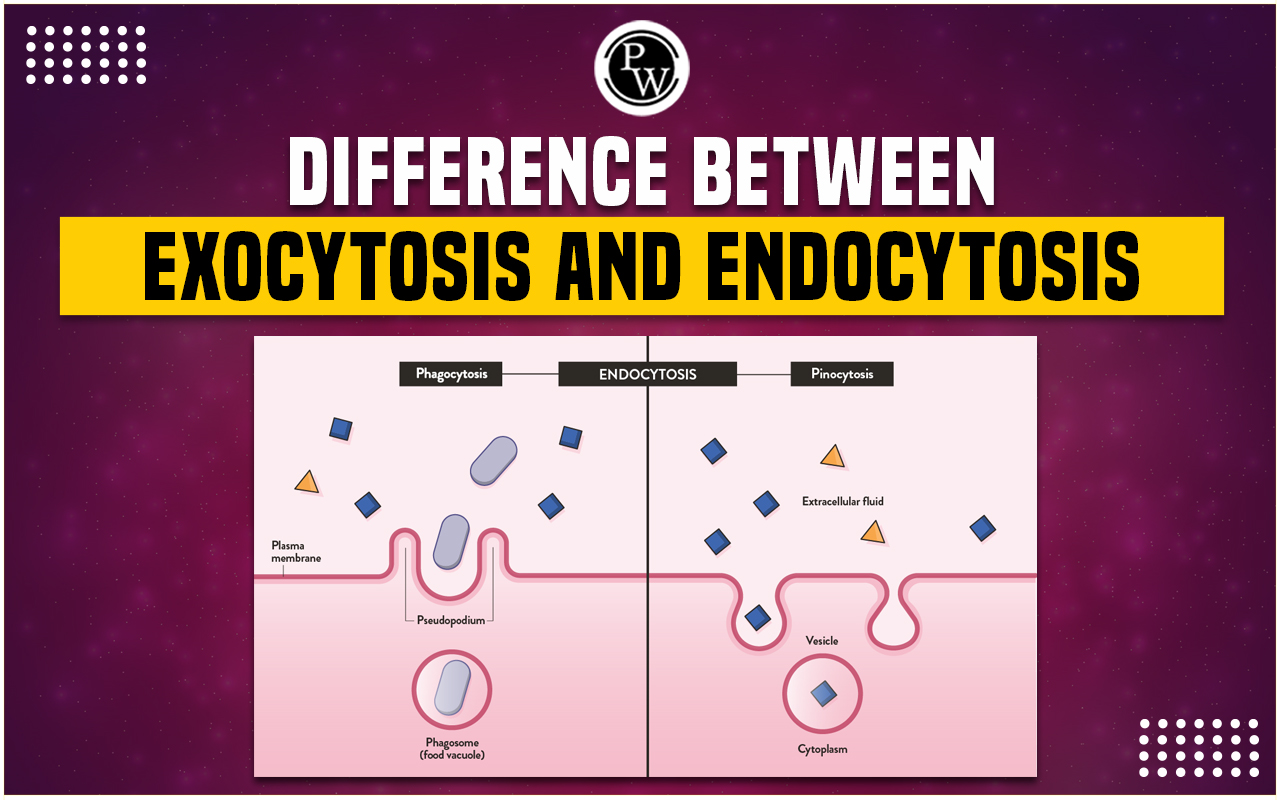

Difference Between Exocytosis And Endocytosis: Exocytosis and endocytosis are two mechanisms used by cells to transport substances into or out of the cell that are too large to pass directly through the lipid bilayer of the cell membrane. These processes help large molecules, microorganisms, and waste products cross the cell membrane.
| NEET Biology Syllabus | NEET Biology Diagrams |
| NEET Biology MCQ | NEET Biology Chapter wise Weightage |
| NEET Biology Notes | NEET Previous Year Question papers |
Endocytosis occurs when cells engulf substances from outside the cell and enclose them in a vesicle formed from the cell membrane. Exocytosis, on the other hand, is the process by which cells release materials from within the cell, such as waste products, into the extracellular space. Exocytosis is the process by which materials are enclosed in a vesicle formed by the cell membrane. The detailed difference between exocytosis and endocytosis is provided in the article below.
Difference Between Exocytosis And Endocytosis Overview
Cells have four types of transportation methods: diffusion, active transport, osmosis, and bulk transport. The bulk transport includes two main processes called exocytosis and endocytosis. These processes help move large particles through the cell's outer membrane. Endocytosis functions as a mechanism to internalize large molecules from outside the cell, such as proteins, insoluble particles, or microorganisms. There are three primary types of endocytosis: pinocytosis, phagocytosis, and receptor-mediated endocytosis. Pinocytosis is nonspecific, while phagocytosis targets larger structures like bacteria or food particles without specificity. In contrast, receptor-mediated endocytosis is specific to substances recognized by cell-surface receptors. Engulfing bacteria by phagocytes is the main example of endocytosis. Exocytosis, on the other hand, involves the secretion of large molecules from within the cell to the extracellular space. This process includes proteins and glycoproteins, such as digestive enzymes and various peptide or polypeptide hormones, which are released into the extracellular fluid or circulation. Additionally, exocytotic pathways transport membrane proteins produced within cells to the cell surface. An example of exocytosis is realizing hormones outside the cell. This article will explore the difference between exocytosis and endocytosis.Difference Between Exocytosis And Endocytosis
Exocytosis is when a cell releases molecules like enzymes or hormones into its surroundings. It does this by merging small sacs, called vesicles, containing the molecules with the cell's membrane. On the other hand, endocytosis is when a cell takes in materials from outside by engulfing them. It can happen through pinocytosis, which is like sipping small amounts of fluid, or phagocytosis, which is like eating larger particles. Endocytosis is important for cells to get nutrients, get rid of waste, and respond to signals from their environment. The table below will help you understand the difference between exocytosis and endocytosis.|
Difference Between Exocytosis And Endocytosis |
||
|---|---|---|
| Characteristic | Exocytosis | Endocytosis |
| Definition | The process of expelling unwanted materials from the cell. | The process of engulfing large particles into the cell. |
| Occurrence | Regulated secretory pathways within the cell. | Through pinocytosis and phagocytosis mechanisms. |
| Process of Transportation | Movement of molecules from within the cell to the external environment. | Transportation of macromolecules from the external environment into the cell. |
| Cell Formation | Contributes to the formation of cellular structures. | Does not contribute to cell formation. |
| Nutrients | Plays a role in removing waste materials from the cell. | Facilitates the uptake of nutrients into the cell. |
| Vesicle Fate | Vesicles ultimately fuse with the cell membrane. | Vesicles fuse with membrane-bound organelles. |
What is Endocytosis?
Endocytosis is the cellular process by which large molecules are internalized. It occurs when the cell membrane engulfs extracellular material, forming a vesicle that contains the ingested substances. There are three primary types of endocytosis:- Phagocytosis: This mechanism involves the cell engulfing large, solid particles, such as bacteria, as part of the immune response. Pseudopodia, extensions of the cytoplasm often likened to 'false feet,' detect and surround the target before enclosing it within a vacuole or phagosome inside the cell membrane. This process is highly specific, targeting specific particles for ingestion.
- Pinocytosis: Pinocytosis is a nonspecific process where the cell takes in fluid from its surroundings, allowing it to absorb nutrients like ions, enzymes, and hormones. During pinocytosis, the cell membrane invaginates, forming small vesicles called pinosomes as they detach and carry the fluid into the cell.
- Receptor-mediated endocytosis: This mechanism involves the uptake of specific molecules, such as iron, through their corresponding receptors on the cell surface. Receptors aggregate in specialized regions known as coated pits, coated with proteins like clathrin. Clathrin facilitates the invagination of the coated pit, forming a vesicle that transports the desired ligand into the cell. This process is exploited by certain toxins, like those found in cholera, to gain entry into the cell.
What is Exocytosis?
Exocytosis is the opposite of endocytosis, in which substances synthesized within the cell are expelled into the external environment. Exocytosis occurs when specialized vesicles containing the desired molecules fuse with the cell membrane, releasing their contents outside the cell. This process is required for cells to secrete important substances like hormones, neurotransmitters, and digestive enzymes. There are two major types of exocytosis:- Constitutive exocytosis: Constitutive exocytosis refers to the continuous and unregulated release of vesicular contents from the cell. It occurs through the fusion of vesicles with the cell membrane, leading to the secretion of molecules such as proteins, lipids, and other cellular components. Constitutive exocytosis helps to maintain the plasma membrane's integrity, deliver newly synthesized components to the cell surface, and replenish membrane lipids.
- Regulated exocytosis: Regulated exocytosis is the process by which cells respond to specific stimuli or signals. This type of exocytosis involves a regulated release of vesicular contents. Specialized cells, such as neurons, endocrine cells, and secretory cells, frequently exhibit regulated exocytosis. For example, regulated exocytosis in neurons allows neurotransmitters to be released in response to an action potential. Similarly, endocrine cells release hormones into the bloodstream in response to specific hormonal or neural signals.
Difference Between Exocytosis And Endocytosis FAQs
What are the two forms of endocytosis?
What are the three stages of endocytosis?
What is a real-life instance of exocytosis?
Is endocytosis an active or passive process?
Does exocytosis rely on proteins?












